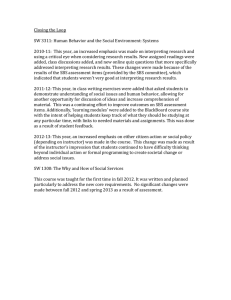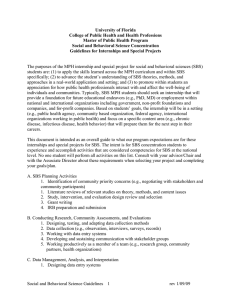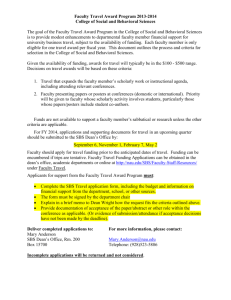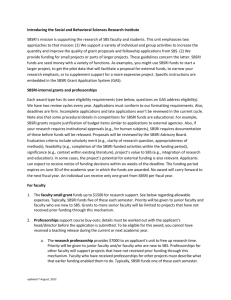Research Journal of Applied Sciences, Engineering and Technology 8(4): 481-487,... ISSN: 2040-7459; e-ISSN: 2040-7467
advertisement
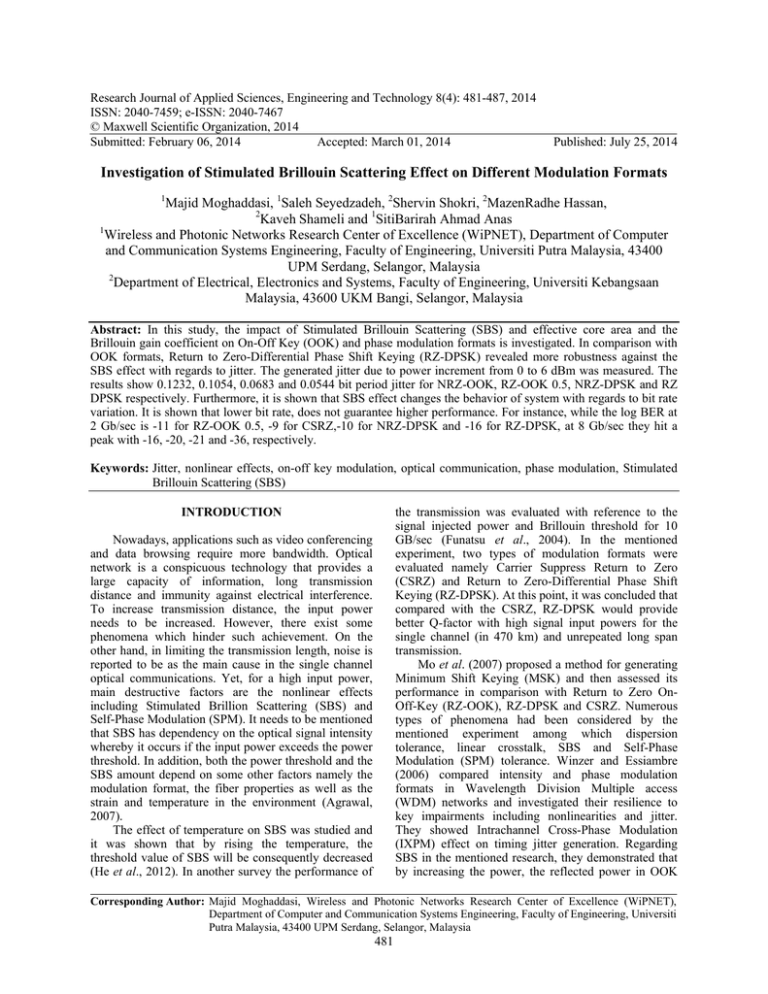
Research Journal of Applied Sciences, Engineering and Technology 8(4): 481-487, 2014 ISSN: 2040-7459; e-ISSN: 2040-7467 © Maxwell Scientific Organization, 2014 Submitted: February 06, 2014 Accepted: March 01, 2014 Published: July 25, 2014 Investigation of Stimulated Brillouin Scattering Effect on Different Modulation Formats 1 Majid Moghaddasi, 1Saleh Seyedzadeh, 2Shervin Shokri, 2MazenRadhe Hassan, 2 Kaveh Shameli and 1SitiBarirah Ahmad Anas 1 Wireless and Photonic Networks Research Center of Excellence (WiPNET), Department of Computer and Communication Systems Engineering, Faculty of Engineering, Universiti Putra Malaysia, 43400 UPM Serdang, Selangor, Malaysia 2 Department of Electrical, Electronics and Systems, Faculty of Engineering, Universiti Kebangsaan Malaysia, 43600 UKM Bangi, Selangor, Malaysia Abstract: In this study, the impact of Stimulated Brillouin Scattering (SBS) and effective core area and the Brillouin gain coefficient on On-Off Key (OOK) and phase modulation formats is investigated. In comparison with OOK formats, Return to Zero-Differential Phase Shift Keying (RZ-DPSK) revealed more robustness against the SBS effect with regards to jitter. The generated jitter due to power increment from 0 to 6 dBm was measured. The results show 0.1232, 0.1054, 0.0683 and 0.0544 bit period jitter for NRZ-OOK, RZ-OOK 0.5, NRZ-DPSK and RZ DPSK respectively. Furthermore, it is shown that SBS effect changes the behavior of system with regards to bit rate variation. It is shown that lower bit rate, does not guarantee higher performance. For instance, while the log BER at 2 Gb/sec is -11 for RZ-OOK 0.5, -9 for CSRZ,-10 for NRZ-DPSK and -16 for RZ-DPSK, at 8 Gb/sec they hit a peak with -16, -20, -21 and -36, respectively. Keywords: Jitter, nonlinear effects, on-off key modulation, optical communication, phase modulation, Stimulated Brillouin Scattering (SBS) the transmission was evaluated with reference to the signal injected power and Brillouin threshold for 10 GB/sec (Funatsu et al., 2004). In the mentioned experiment, two types of modulation formats were evaluated namely Carrier Suppress Return to Zero (CSRZ) and Return to Zero-Differential Phase Shift Keying (RZ-DPSK). At this point, it was concluded that compared with the CSRZ, RZ-DPSK would provide better Q-factor with high signal input powers for the single channel (in 470 km) and unrepeated long span transmission. Mo et al. (2007) proposed a method for generating Minimum Shift Keying (MSK) and then assessed its performance in comparison with Return to Zero OnOff-Key (RZ-OOK), RZ-DPSK and CSRZ. Numerous types of phenomena had been considered by the mentioned experiment among which dispersion tolerance, linear crosstalk, SBS and Self-Phase Modulation (SPM) tolerance. Winzer and Essiambre (2006) compared intensity and phase modulation formats in Wavelength Division Multiple access (WDM) networks and investigated their resilience to key impairments including nonlinearities and jitter. They showed Intrachannel Cross-Phase Modulation (IXPM) effect on timing jitter generation. Regarding SBS in the mentioned research, they demonstrated that by increasing the power, the reflected power in OOK INTRODUCTION Nowadays, applications such as video conferencing and data browsing require more bandwidth. Optical network is a conspicuous technology that provides a large capacity of information, long transmission distance and immunity against electrical interference. To increase transmission distance, the input power needs to be increased. However, there exist some phenomena which hinder such achievement. On the other hand, in limiting the transmission length, noise is reported to be as the main cause in the single channel optical communications. Yet, for a high input power, main destructive factors are the nonlinear effects including Stimulated Brillion Scattering (SBS) and Self-Phase Modulation (SPM). It needs to be mentioned that SBS has dependency on the optical signal intensity whereby it occurs if the input power exceeds the power threshold. In addition, both the power threshold and the SBS amount depend on some other factors namely the modulation format, the fiber properties as well as the strain and temperature in the environment (Agrawal, 2007). The effect of temperature on SBS was studied and it was shown that by rising the temperature, the threshold value of SBS will be consequently decreased (He et al., 2012). In another survey the performance of Corresponding Author: Majid Moghaddasi, Wireless and Photonic Networks Research Center of Excellence (WiPNET), Department of Computer and Communication Systems Engineering, Faculty of Engineering, Universiti Putra Malaysia, 43400 UPM Serdang, Selangor, Malaysia 481 Res. J. App. Sci. Eng. Technol., 8(4): 481-487, 2014 formats was much higher in comparison with DPSK and MSK. Few experiments have been conducted so far investigating the correlation of SBS effect and different modulation formats. In this study, the effect of SBS, along with some of its components, on different modulation format has been investigated. The role of duty cycle is also considered in the experiment. The duty cycle of a periodic intensity waveform is the percentage of 'on' time during the period T (Majumdar and Ricklin, 2008). Thus, RZ-OOK 0.5 and RZ-OOK 0.33 mean RZ-OOK modulation formats which the percentage of the ratio between their pulse durations and period T is 50 and 33%, respectively. Furthermore, CSRZ is RZ-OOK with 67% duty cycle while its characteristic is optical field reversion corresponding to a π phase shift at each bit transition. The fact is that such a feature led to the suppression of the carrier frequency (Da Silveira et al., 2011). In this study, produced jitter due to SBS effect, variation of bit rate, core area and gain coefficient under SBS effect is investigated. Fig. 1: Power threshold with regards to SBS gain coefficient for Ac = 50 and 80 µm2 (Ac denotes effective core area of fiber) Table 1: Typical parameters used in the calculation Parameters Value Wavelength 1.55 Bit rate 10 Power 9 Line width 9 Fiber length 200 n 2 nonlinear index coefficient 26×10-21 Brillouin gain constant 5×10-11 Brillouin line width 100 MATERIALS AND METHODS SBS is a single channel non-linear impairment which limits the power available from narrow-linewidth fiber optical communication systems (Dragic et al., 2012). In this situation, a portion of the injected light is backscattered toward the source while increasing the mentioned power would reinforce this reflected light which acts as noise. This issue is depicted in Fig. 1, where SBS power threshold was set to 5 mW. The main physical factor that induces such a phenomenon is that the material tends to be compressed in presence of the electrical field; subsequently, an acoustic wave is generated which in turn causes scattering of the pump wave. For 1550 nm wavelength, the interaction happened at line width ΔfB from 20 to 100 MHz which transmitted in the opposite direction of the pumped laser. While this small line width was unable to make any inter channel interaction issue for WDM, it could cause distortion for single channel transmission (Agrawal, 2007). SBS gain coefficient gB is another term which is defined in the SBS phenomenon. For silica fibers, the range is from 2×10-11 to 5×10-11. Brillouin-gain spectrum is very narrow whose bandwidth is less than 100 MHz. Whereas for long transmission distance (L>>1/α), the effective length Leff = 20 km (Ramaswami et al., 2009). Therefore SBS power threshold can be attained via: 21𝐾𝐾𝐴𝐴𝑒𝑒 𝑃𝑃𝑡𝑡ℎ = 𝑔𝑔 𝐵𝐵 𝐿𝐿𝑒𝑒𝑒𝑒𝑒𝑒 �1 + ∆𝑓𝑓𝑝𝑝 ∆𝑓𝑓 𝐵𝐵 � Unit µm Gb/sec dBm MHz km m2/W m/W MHz scrambling in conventional SMF, K is equal to 2 (Chen and Meng, 2011). Figure 1 the variation of power threshold regards with SBS gain coefficient for two different core areas are seen. For this experiment, the simulation was implemented via the commercial software called OptiSystem (version 10). The system model is depicted in Fig. 2 and the parameters values are provided in Table 1. The Bit Error Rate (BER) was chosen as the performance parameter and the impact of SBS and two of its contributing parameters, namely the effective core area and the SBS gain coefficient, on different modulation formats were investigated. Selected modulation formats were Non Return to Zero (NRZOOK), RZ-OOK with three popular duty cycles (33, 50 and 67%, respectively), Non Return to ZeroDifferential Phase Shift Keying (NRZ-DPSK) and RZDPSK. Noise was kept constant and the chromatic dispersion was compensated. Therefore, any changes in the system performance will be caused by the SBS effect. Nonlinearities were abandoned in the Dispersion Compensation Fiber (DCF) because of the slight power pumped into it (Kissing et al., 2002). For very long links where L>>1/α, the Leff = 20 km (Ramaswami et al., 2009) and based on (2), γ = 2.1 W-1/km and with φNL = 0.1, the power threshold for the SPM effect (1) where, Ae and Le are the effective area and the effective length of the fiber, respectively. K is called the polarization factor while for a complete polarization 482 Res. J. App. Sci. Eng. Technol., 8(4): 481-487, 2014 Fig. 2: Experimental setup of the system under test CW Laser: Continuous wave laser; MZM: Mach-zehnder modulator; SMF: Single mode fiber; Apm: Optical amplifier; DCF: Dispersion compensation fiber will be about 9.5 dBm; accordingly, it will not affect the system output. On the other hand, considering (1), the power threshold for SBS will be about 3 dBm. Hence, it is expected that the impact of SBS would start from this point. In addition, it has been pointed out that the amount of temperature variation influences the SBS threshold (He et al., 2012) and the Brillouin shift and backscattering light intensity are the functions of the temperature. For this reason, the temperature of the system was kept constant at 300 K during the whole experiment. decrement for OOKs. Such an incident was indeed expected since the advantages of phase modulation formats in presence of nonlinear effects have been indicated by other researchers (Gene et al., 2004; Ferber et al., 2005). Among RZ-OOKs with different duty cycles, CSRZ still shows better quality than the others do and it allows higher power levels to be transmitted although it plunges same as other OOK formats. This superiority is because the suppression carrier in CSRZ corresponds to the highest power component in the RZ-OOK spectrum. As a result, this suppression provides a higher tolerance to non-linear effects as compared with the other RZOOK formats (Da Silveira et al., 2011). Overall, RZOOK shows better performance than NRZ-OOK, while the duty cycle has little impact on the performance of this code. This result corresponds with previous research (Wang and Lyubomirsky, 2010). Owing to the importance of the power issue, the impact of power increment for NRZ-OOK and NRZDPSK and also for RZ-OOK and RZ-DPSK was evaluated. Eye diagram for NRZ-OOK and NRZ-DPSK is represented in Fig. 4 which induced jitter can be extracted from it. In Fig. 4a and c the eye diagram was measured for P = 0 dBm and for (b) and (d) P = 6 dBm. Since, as it was mentioned before, power threshold for SPM is 9.5 dBm, the SBS effect was significant but no SPM effect was observed at all. In the both aforementioned formats, the changes in the eye height were trivial; nevertheless, the changes in jitter were considerable. In Fig. 4a and b, the jitters were measured for NRZ-OOK and obtained equal to 0.0723 bit period and 0.1955 bit period, respectively. Subsequently, it was inferred that SBS caused 0.1232 bit period jitter. The same measurement was accomplished for NRZDPSK as displayed in Fig. 4c and d. It was observed that jitter is increased from 0.0497 bit period to 0.118 bit period; this implies that only 0.0483 bit period was induced because of SBS. It needs to be highlighted that similar results was achieved for RZ-OOK and RZDPSK. While RZ-OOK 0.5 experienced 0.1054 bit period jitter increment (from 0.0754 to 0.1778), RZ- RESULTS AND DISCUSSION In Fig. 3, the effect of the input power in an optical communication system has been illustrated. The power of the transmitter was varied from 0 to 10 dBm and other parameters were kept constant based on Table 1. As it is observed, in the lower injected power, OOK formats offer good quality for the system. However, with power increment, their qualities reduce rapidly while the phase modulated formats such as NRZ-DPSK and RZ-DPSK excel once a higher power is injected. The system works well until P = 2 dBm; however, after such a point all the OOK formats decrease while this degradation continues with power increment until the end. For example, the BER of NRZ-OOK and RZ-OOK 0.5 increases from 10-36 and 10-42 in P = 2 dBm to 1016 and 10-21 in 8 dBm, respectively. The reason is that the SBS deterioration rises with power increment producing a noise in the system. Contrary to the OOK formats, phase modulations do not suffer from the power increment that much. NRZ-DPSK reaches from 10-32 at 2 to 10-25 at 8 dBm. Meanwhile, RZ-DPSK yields an excellent stability while its BER reaches from 10-38 at 2 to 10-36 at 8 dBm. This result approves the superiority of RZ-DPSK compared to NRZ-DPSK which was expected Zhang et al. (2010) and the weakness of the OOK formats against the SBS increment effect. This is because of the fact that the reflected power in the OOK formats is much higher compare with phase modulation formats (Mo et al., 2007) and it causes SNR 483 Res. J. App. Sci. Eng. Technol., 8(4): 481-487, 2014 Fig. 3: Bit Error Rate (BER) of different modulation formats against variation of input power (a) (b) (c) (d) Fig. 4: Power eye diagram of NRZ-OOK with transmitted power of (a) 0 dBm, (b) 6 dBm and NRZ-DPSK with transmitted power of (c) 0 dBm and (d) 6 dBm 484 Res. J. App. Sci. Eng. Technol., 8(4): 481-487, 2014 Fig. 5: BER performance with regards to bit rate variation without SBS effect Fig. 6: BER of different modulations for various bit rates when the transmitted power is 8 dBm performances with regards to bit rate variation with SBS effect DPSK experienced only 0.0544 bit period jitter increment (from 0.0857 bit period to 0.0313). Thus, it can be inferred that the phase modulations are more robust against jitter due to the SBS effect. At the next stage, the correlation between SBS and bit rate are investigated. In Fig. 5, the effect of increasing the bit rate on different modulation formats are seen. SBS effect has been disabled in the system. As it was expected, with bit rate increment, the system performance is decreased. For example while with bit rate 2 Gb/sec, RZ-OOK 0.33 provides log BER -24, while with 14 Gb/sec, the performance of the system reaches to -7. On the other hand, with adding SBS effect to the system, its behavior completely changes. In this situation, the optimum bit rate is not the least one. In Fig. 6, it can be observed that all modulation formats, reach the high at 6 or 8 Gb/sec. For instance, RZ-OOK 0.33 hits the peak at 6 Gb/sec with log BER -15. On the other hand, RZ-OOK 0.5, CSRZ, NRZ-DPSK and RZDPSK reach a high at 8 Gb/sec with log BER -17, -16, 26 and -38, respectively. The number for these modulation formats at 2 Gb/sec are -8 for RZ-OOK 0.33, -8 for RZ-OOK 0.5, -4 for CSRZ, -9 for NRZDPSK and -16 for RZ-DPSK. Therefore contrary to common belief, lower bitrate does not guarantee higher performance under SBS effect and optimum point should be attained. Besides, in the current research the impact of the effective area on different modulation formats is investigated. It needs to be asserted that the effective area is a contributor to both SBS and SPM. Therefore, a distinction must be considered for analyzing the graph. In Fig. 7 the effective core area, Aeff, has been varied from 40 to 90 µm2. The impairment due to the area variation can be ascribed to the SBS effect where 485 Res. J. App. Sci. Eng. Technol., 8(4): 481-487, 2014 Fig. 7: BER of systems with different modulation formats versus variation of fiber effective core area Fig. 8: System performance of different modulation formats against SBS gain coefficient Aeff = 40 to 90 leads to the SBS power threshold 2-6 dBm. As it is discerned, this variation affects RZ-DPSK slightly although it is considerable in NRZ-DPSK; the log of BER will decrease from -19 to -24. On the other hand, the variation for the OOK modulation formats is significant. While CSRZ is the most sensitive one, the performance changes from -12 to -36 are followed by RZ-OOK 0.5 which ranging from -10 to -31. RZ-OOK 0.33 is the most stable format among the OOKs with -12 (from -12 to -18) followed by NRZOOK with a change from -8 to -22. In Fig. 8, it can be observed that the amount of SBS gain coefficient rose from 30 m/W to 60. Same as the other aforesaid factors, RZ-DPSK offers the most stability and robustness against that. The log of BER degrades from -38 to -35 which is negligible. NRZDPSK reveals analogous behavior and has a slight degradation from -24 to -21. Furthermore, CSRZ and RZ-OOK 0.5 demonstrated the highest vulnerability compared to the others with degradation from -39 to -16 and -33 to -14, respectively, while RZ-OOK 0.33 declined from -19 to -8 which is the most stable format among the OOKs. It is followed by NRZ-OOK which downgrades from -23 to -11. CONCLUSION In this study, the impact of Stimulated Brillouin Scattering on different modulation formats including NRZ-OOK, RZ-OOK, CSRZ, NRZ-DPSK, RZ-DPSK with regards to bit rate variation and jitter were investigated. Regarding jitter, NRZ-DPSK and RZ_DPSK showed superiority against jitter due to SBS as compared to NRZ-OOK and RZ-OOK. With power increment from 0 to 6 dBm, the generated jitters were measured for NRZ-OOK and RZ-OOK 0.5. The obtained values were 0.1232 for NRZ-OOK and 0.1054 bit period for RZ-OOK, respectively. At the end, NRZDPSK and RZ-DPSK gave 0.0683 and 0.0544 bit period jitter, respectively. On the other hand, the effect 486 Res. J. App. Sci. Eng. Technol., 8(4): 481-487, 2014 of SBS on the system, when its bit rate is varied, was investigated. It is shown that higher performance is not achieved at lower bit rat. But there is an optimum bit rate for each system that can provide the best performance. Gene, J.M., M. Soler, R.I. Killey and J. Prat, 2004. Investigation of 10-Gb/s optical DQPSK systems in presence of chromatic dispersion, fiber nonlinearities and phase noise. IEEE Photonic. Tech. L., 16(3): 924-926. He, X., Y. Tang, J. Shi, J. Liu, W. Cheng and X. Mo, 2012. Investigation of the influence of temperature on threshold value and pulse duration of stimulated Brillouin scattering in liquid water. J. Mod. Optic., 59(16): 1410-1414. Kissing, J., S. Vorbeck, M. Plura and E. Voges, 2002. Design of high data rate optical transmission systems with self phase modulation and noise. Electr. Eng., 84: 123-128. Majumdar, A.K. and J.C. Ricklin, 2008. Free-space Laser Communications: Principles and Advances. Vol. 2, Springer Verlag, New York, ISBN-13: 9780-387-28652-5. Mo, J., Y.J. Wen, Y. Wang, C. Lu and W.D. Zhong, 2007. Externally modulated optical minimum shift keying format. J. Lightwave Technol., 25(10): 3151-3160. Ramaswami, R., K.N. Sivarajan and G.H. Sasaki, 2009. Optical Networks: A Practical Perspective. Morgan Kaufmann, Elsevier, Burlington, MA, ISBN: 9780-12-374092-2. Wang, Y.H. and I. Lyubomirsky, 2010. Impact of DPQPSK pulse shape in nonlinear 100 G transmission. J. Lightwave Technol., 28(18): 2750-2756. Winzer, P.J. and R.J. Essiambre, 2006. Advanced optical modulation formats. P. IEEE, 94(5): 952-985. Zhang, C., P. Zhang and L. Geng, 2010. A survey of advanced modulation formats for high-speed transmission. Proceeding of 2010 International Conference on Computer Application and System Modeling (ICCASM, 2010), 8: 248-252. ACKNOWLEDGMENT The authors would like to acknowledge University Putra Malaysia (UPM) for supporting this study by providing equipment, material and sources of references in accomplishing this study. REFERENCES Agrawal, G.P., 2007. Nonlinear Fiber Optics. Elsevier Inc., U.S.A., ISBN: 13:978-0-12-369516-1. Chen, W. and Z. Meng, 2011. Relative intensity noise induced by four-wave mixing in the case of twowave transmission in an optical fiber. Opt. Laser Technol., 43(7): 1270-1273. Da Silveira, C.R., D.M. Pataca, M.A. Romero and M. De Lacerda Rocha, 2011. A cost-benefit analysis on modulation formats for 40-Gb/s optical communication systems. P. Soc. Photo-Opt. Ins., 30(2): 87-101. Dragic, P., J. Ballato, A. Ballato, S. Morris, T. Hawkins and P. Law, 2012. Mass density and the Brillouin spectroscopy of aluminosilicate optical fibers. Opt. Mater. Express, 2(11): 1641-1654. Ferber, S., R. Ludwig, C. Boerner and C. Schubert, 2005. 160 Gbit/s DPSK transmission over 320 km fibre link with high long-term stability. Electron. Lett., 41: 200-202. Funatsu, G., H. Maeda and A. Naka, 2004. Suppression of stimulated Brillouin scattering by using RZDPSK format in long-span unrepeatered transmission system. Proceeding of IEEE/LEOS Workshop on Advanced Modulation Formats, pp: 17-18. 487
